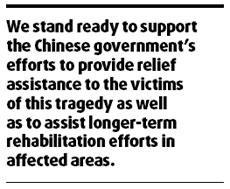Why China is crucial to world food security
By Anthea Webb (China Daily)
Updated: 2008-05-15 07:27
Updated: 2008-05-15 07:27

The United Nations in China would like to express its sympathy for the thousands of people who have lost lives and been affected by the earthquake which struck Southwest China on Monday.
We are deeply concerned and are closely monitoring the situation with special attention to the reports of growing numbers of additional causalities. We stand ready to support the Chinese government's efforts to provide relief assistance to the victims of this tragedy as well as to assist longer-term rehabilitation efforts in affected areas.
For us, it is very hard to predict now how bad the impact of the calamity will be and what kinds of impact it will have on China, especially at a time when the world is sliding into a food crisis.
Whatever happened, China still played a very important role in the world's food security.
Last week Premier Wen Jiabao said that "China is deeply concerned about food security", and announced that the government would give $2 million to the United Nations World Food Program (WFP) in response to the extraordinary difficulties it is facing as a result of rising food prices.
This brings China's donation to WFP in 2008 to $4.5 million: the largest donation ever made by China to WFP for use in other developing countries.
The premier also said that by ensuring China can provide sufficient food for its population of 1.3 billion people, the country is making a major contribution to world food security.
At a moment when world food security is facing unprecedented challenges from rising prices, China's role is fundamental.
Over the past year the Food and Agriculture Organization (FAO)'s food price index has risen by 57 percent. On the international market, the price of staple foods like wheat and rice has more than doubled.
Shoppers from Beijing to Boston to Brussels have seen their grocery bill rise rapidly. For the wealthier consumers, who spend 10 to 20 percent of their income on food, that means cutting back on the number of times they eat at restaurants, or on desserts and other treats.
But for people who were just able to make ends meet last year, the increases in prices of basic foods such as bread and rice are disastrous. The people who spend more than half of their income putting food on the family table are now faced with the prospect of cutting back on more nutritious foods like meat and dairy. The very poorest - those who survive on 50 cents a day - have started to reduce the number of meager meals they eat each day.
The WFP's executive director has called the effect a "silent tsunami". Like the tsunami that swept across the Indian Ocean in December 2004, this wave of high prices knows no borders. It is bringing a surge of suffering to poor people across the globe and its effects such as increased malnutrition and poverty will be felt for years to come.
What has caused this dramatic change in food prices?
Firstly, demand for food has changed. Once upon a time, grains like wheat, corn and rice, were used mainly as food for people. Today, however, these simple foods are also used to produce feed for animals and ethanol for biofuels.
Secondly, high crude oil prices have impacted the cost of producing food. Unfortunately, few farmers are reaping the benefit of high food prices since the cost of fertilizers, fuel for their machinery and transport to market have also risen, meaning their profit margins have decreased.
Thirdly, the weather also plays a big part in agriculture and recent years have seen serious droughts in major grain-exporting nations such as Australia. Cyclone Nargis, which devastated much of the Irrawaddy Delta in Myanmar, is also likely to contribute to higher rice prices, since it has destroyed much of this year's crop.
On top of the suffering currently facing the people affected directly by the Cyclone, the people of Sri Lanka and Bangladesh, who had planned to buy some of that rice, will find it even harder to meet their needs this year.
This uncanny convergence of factors - new demands for grains, rising production costs and reduced supply because of bad weather - have created an economic "perfect storm".
Where does China fit into this picture? Already, by producing food for more than 20 percent of the world's population on less than 10 percent of its arable land, China is carrying a heavy burden for global food security.
It is the world's largest producer of grain, and production has increased every year for the past four years, reaching 501.5 million tons last year. More than 95 percent of the grain it needs is grown in China.
The State Grain Administration estimates its grain reserves hold between 150 and 200 million tons - enough to meet up to six months' consumption and well above the 18 percent of consumption recommended by FAO.
But China is not immune to food price pressure. Food, which accounts for 30 percent of the basket of goods on which inflation is calculated, has been blamed for the high levels of inflation recorded in the past year.

Those increases have been attributed to rises in three main commodities: pork because a disease killed many of the herd last year; fruit and vegetables because the snow and ice storms in southern China in January and February destroyed many horticultural crops; and cooking oil because it relies heavily on soybean imports, the international price of which has grown steadily over recent years.
The government has demonstrated its concern over the issue of domestic food prices by introducing 10 measures to boost production and contain prices.
These include incentives for farmers, restrictions on exports and limits on the use of food for biofuel production. Many commodity analysts - including the World Food Program - are counting on those measures to be successful.
Notwithstanding the impressive increases in grain production in China over the past 30 years, the country's farmers face a tough challenge to keep increasing the amount of grain they grow at the same pace as demand is rising. The amount of land and water available for agriculture is decreasing, so much will depend on them being able to get better yields. And the best incentive is for farming to be profitable.
Personally, I am optimistic that China's farmers can rise to this challenge, with the right kind of support from the government.
I have seen how hard-working farmers in rural Anhui province toil to grow wheat, rice, rapeseed and vegetables not just for their families but for other provinces too.
I have also seen that many of them still rely on buffaloes to till their fields and on rainfall to water their crops. Better machinery and irrigation could help this productive province grow even more.
China has already made so much progress, reducing the number of undernourished people by more than 150 million over the past 30 years. Then, one in three Chinese children was malnourished; today just 7 percent of children are too short for their age, a sign of poor nutrition.
In fact, the average 6-year-old boy in China today is 6 kg heavier and 6 cm taller than he would have been 30 years ago. That's concrete evidence of better diets and health.
China, perhaps better than any other developing country, has seen first hand how economic development depends on food security. It knows that growing economies need healthy, well-nourished and well-educated workers. Now the world is counting on its farmers being able to continue increasing the amount of grain they can grow, to meet growing requirements at home and to stabilize prices.
WFP is hoping that it can learn from China's tremendous progress, and export some of the lessons - as well as financial and other support - to developing countries which are still struggling with poverty and hunger.
The author is Director of the World Food Program in China
(China Daily 05/15/2008 page9)
|
|
|
|